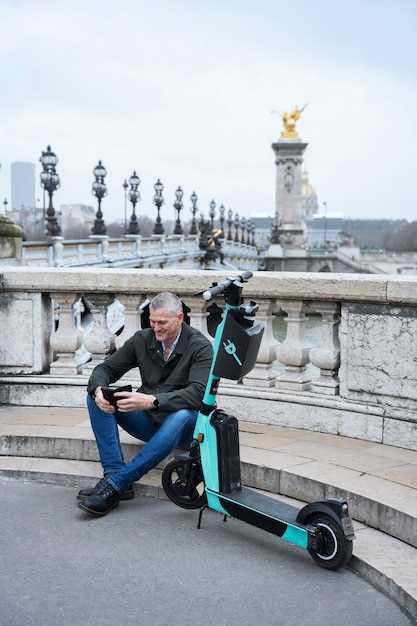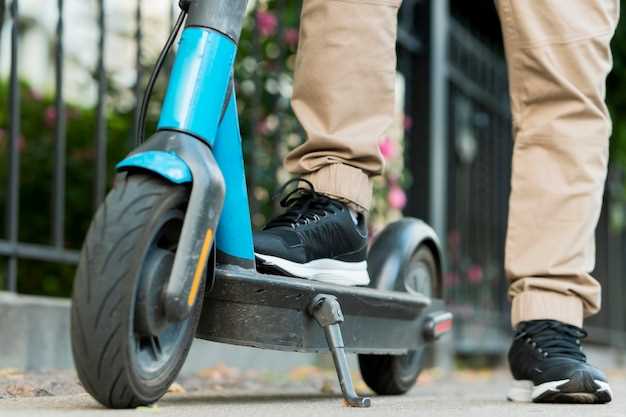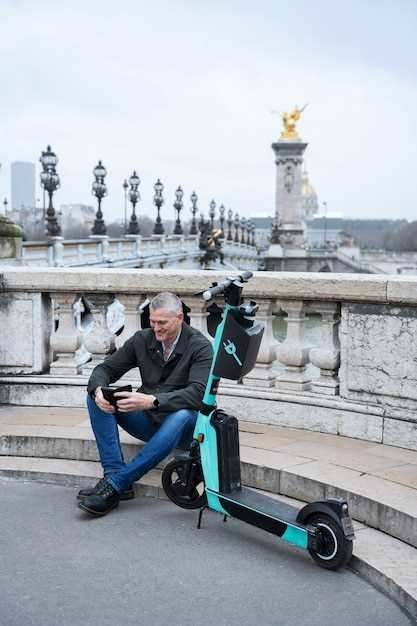
Embark on an exhilarating journey through the city streets, parks, and scenic landscapes with the revolutionary mode of transportation that has taken the world by storm. Whether you’re a seasoned rider or a curious beginner, mastering the art of gliding on a self-balancing personal transporter, commonly known as a Segway, is an experience like no other.
Unleash your inner explorer as you effortlessly navigate through bustling crowds, effortlessly weaving in and out of obstacles with grace and precision. But before you embark on your Segway adventure, it’s crucial to equip yourself with the knowledge and skills necessary to ensure a safe and enjoyable ride.
Prepare to delve into a comprehensive guide that will arm you with essential tips and techniques to conquer any terrain with confidence. From mastering the art of balance and control to understanding the intricacies of maneuvering, this article will provide you with the tools you need to become a Segway maestro.
Understanding Segway Basics
In this section, we will explore the fundamental concepts and principles behind operating a Segway. By gaining a deeper understanding of these basics, you will be better equipped to navigate and enjoy your Segway ride safely and confidently.
Firstly, let’s discuss the anatomy of a Segway. A Segway consists of several key components, including the handlebar, the platform, and the wheels. The handlebar serves as the control center, allowing you to steer and control the Segway’s movements. The platform is where you stand, providing stability and support. The wheels, typically two in number, are responsible for propelling the Segway forward or backward.
Next, it is important to understand how a Segway maintains balance. Segways utilize a sophisticated system of sensors and gyroscopes to detect and respond to changes in balance. These sensors constantly monitor your body position and make adjustments to keep the Segway upright. By distributing your weight evenly and maintaining a relaxed posture, you can help the Segway maintain its balance and stability.
Another crucial aspect to grasp is the concept of lean-steer control. Unlike traditional vehicles, Segways are controlled by shifting your body weight rather than using a steering wheel or handlebars. By leaning forward, you can accelerate and move forward, while leaning backward slows down or reverses the Segway. Additionally, leaning to the left or right allows you to turn in the respective direction. Mastering the art of lean-steer control is essential for a smooth and controlled Segway ride.
Lastly, it is important to be aware of the speed and terrain limitations of a Segway. Segways are designed for use on flat, even surfaces and are not suitable for off-road or rough terrain. It is crucial to adhere to the recommended speed limits and avoid exceeding them, as excessive speed can compromise your safety and control over the Segway.
| Key Points: |
|---|
| 1. Segways consist of a handlebar, platform, and wheels. |
| 2. Segways use sensors and gyroscopes to maintain balance. |
| 3. Lean-steer control is used to maneuver a Segway. |
| 4. Segways have speed and terrain limitations. |
Essential Safety Gear for Segway Riders
Ensuring your safety while riding a Segway is of utmost importance. To protect yourself from potential accidents and injuries, it is essential to have the right safety gear. This section will outline the necessary equipment you should have before embarking on a Segway ride.
1. Helmet

A helmet is a crucial piece of safety gear that should be worn at all times when riding a Segway. It provides protection for your head in case of a fall or collision. Choose a helmet that fits properly and meets the necessary safety standards.
2. Knee and Elbow Pads

Wearing knee and elbow pads can help prevent injuries to these vulnerable areas in case of a fall. They provide cushioning and support, reducing the impact on your joints and bones. Look for pads that are comfortable, adjustable, and offer adequate protection.
3. Wrist Guards
Wrist guards are essential for protecting your wrists from fractures or sprains in case of a fall. They provide stability and support to your wrists, reducing the risk of injury. Choose wrist guards that fit properly and allow for a full range of motion.
4. Reflective Clothing
Wearing reflective clothing is crucial for enhancing your visibility, especially when riding a Segway at night or in low-light conditions. Reflective vests, jackets, or bands can help drivers and pedestrians see you more easily, reducing the risk of accidents.
5. Closed-Toe Shoes
Wearing closed-toe shoes is important to protect your feet while riding a Segway. They provide stability and prevent your feet from getting injured by debris or obstacles on the road. Choose shoes with a good grip to ensure proper control of the Segway.
By equipping yourself with the essential safety gear mentioned above, you can enjoy a smooth and enjoyable Segway ride while minimizing the risk of accidents and injuries.
Mastering Segway Balance and Control
Developing a strong sense of balance and control is essential for a successful and enjoyable experience on a Segway. In this section, we will explore the key techniques and strategies to help you become a master of Segway balance and control.
Understanding Weight Distribution
One of the fundamental aspects of mastering Segway balance is understanding weight distribution. By distributing your weight evenly between your feet and maintaining a centered posture, you can achieve optimal stability on the Segway. It is important to keep your body relaxed and avoid leaning too far forward or backward, as this can disrupt your balance and control.
Utilizing Body Movements
Another crucial aspect of mastering Segway control is utilizing body movements to navigate and maneuver. By leaning slightly forward, you can initiate forward motion, while leaning backward will slow down or stop the Segway. Additionally, subtle shifts in your body weight can help you make turns smoothly and efficiently. It is important to practice these movements in a controlled environment before venturing into more challenging terrains.
Remember: Maintaining a strong core and engaging your abdominal muscles can greatly enhance your balance and control on the Segway. By keeping your core stable, you can better absorb any bumps or uneven surfaces, ensuring a smoother and safer ride.
Mastering Segway balance and control requires practice and patience. By understanding weight distribution, utilizing body movements, and engaging your core, you can confidently navigate various terrains and enjoy a seamless Segway experience.
Navigating Different Terrains on a Segway
Mastering the art of maneuvering a Segway across various landscapes is essential for a seamless and enjoyable ride. As you embark on your Segway adventure, it is crucial to understand how to navigate different terrains to ensure your safety and maximize your experience.
When encountering uneven surfaces, such as gravel or cobblestones, it is important to maintain a balanced stance on your Segway. Distribute your weight evenly and keep a firm grip on the handlebars to maintain control and stability. Adjust your speed accordingly, slowing down to navigate through rough patches and maintaining a steady pace on smoother sections.
When faced with inclines or declines, adapt your body position to maintain stability and control. Lean slightly forward when ascending to shift the weight towards the front wheel, providing better traction. Conversely, lean slightly backward when descending to prevent the Segway from gaining excessive speed. Remember to always keep your knees slightly bent and your body relaxed to absorb any bumps or changes in terrain.
When encountering grassy or off-road terrains, it is important to adjust your technique to ensure a smooth ride. Maintain a slower speed to navigate through the uneven surface, allowing the Segway’s tires to grip the ground effectively. Keep a relaxed grip on the handlebars and allow your body to move naturally with the terrain, making slight adjustments to maintain balance.
When navigating through urban environments or crowded areas, it is crucial to be aware of your surroundings and adjust your speed accordingly. Slow down when approaching pedestrians, obstacles, or tight spaces to ensure everyone’s safety. Utilize the Segway’s turning capabilities to maneuver through narrow pathways or crowded areas with ease.
By understanding how to navigate different terrains on a Segway, you can confidently embark on your journey, knowing that you have the skills to handle various landscapes. Remember to always prioritize safety, adjust your technique accordingly, and enjoy the unique experience that a Segway ride offers.
Riding Etiquette and Rules of the Road
When it comes to riding a Segway, it is important to not only prioritize safety and enjoyment but also to adhere to proper riding etiquette and follow the rules of the road. By doing so, riders can ensure a smooth and harmonious experience for themselves and others sharing the same space.
One fundamental aspect of riding etiquette is being aware of and respecting the personal space of pedestrians and other riders. It is essential to maintain a safe distance and avoid any unnecessary collisions or close encounters. By being considerate and mindful of others, riders can create a pleasant and cooperative environment.
Additionally, following the rules of the road is crucial for a safe and efficient Segway ride. This includes obeying traffic signals, signs, and regulations, just as one would when driving a vehicle. It is important to stay in designated areas and avoid riding on sidewalks or pedestrian-only zones unless permitted. By adhering to these rules, riders can ensure a smooth flow of traffic and minimize any potential hazards.
Furthermore, communication plays a vital role in riding etiquette. Using hand signals or verbal cues to indicate intentions, such as turning or stopping, can help other riders and pedestrians anticipate movements and avoid any unexpected incidents. Clear and effective communication fosters a sense of trust and cooperation among all individuals sharing the road.
Lastly, it is essential to be aware of one’s surroundings and adapt riding behavior accordingly. This includes adjusting speed to match the flow of traffic, being cautious of blind spots, and anticipating potential obstacles or hazards. By staying alert and proactive, riders can navigate their Segways safely and confidently.
In conclusion, riding etiquette and following the rules of the road are integral to a smooth and enjoyable Segway experience. By respecting personal space, obeying traffic regulations, communicating effectively, and staying aware of surroundings, riders can contribute to a harmonious and safe riding environment for all.
Handling Emergency Situations on a Segway
When riding a Segway, it is important to be prepared for unexpected situations that may arise. This section will provide guidance on how to handle emergency scenarios while ensuring your safety and enjoyment.
Reacting to Equipment Malfunctions
In the event of an equipment malfunction, such as a sudden loss of power or a malfunctioning control panel, it is crucial to remain calm and composed. First, try to regain control of the Segway by gently applying pressure to the handlebars and attempting to steer it to a safe location. If this does not work, it is recommended to dismount the Segway and move it to a secure area away from traffic or potential hazards.
Dealing with Obstacles and Uneven Terrain
Encountering obstacles or navigating through uneven terrain can be challenging while riding a Segway. In such situations, it is important to maintain a steady balance and adjust your body position accordingly. Keep your knees slightly bent and your weight centered over the Segway to ensure stability. When encountering obstacles, such as potholes or curbs, approach them at a slow and controlled speed, using your body movements to absorb any impact. Remember to always be aware of your surroundings and anticipate potential hazards.
In case of an emergency, such as a collision or a fall, it is crucial to prioritize your safety and the safety of others. Assess the situation and determine if medical assistance is required. If necessary, call for help immediately and provide clear and concise information about your location and the nature of the emergency.
By being prepared and knowing how to handle emergency situations on a Segway, you can ensure a safe and enjoyable riding experience. Remember to always follow the manufacturer’s guidelines and receive proper training before operating a Segway. Stay alert, stay safe!


